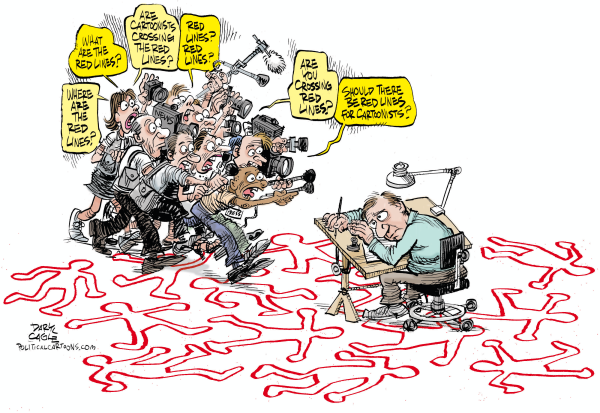I’m in Shanghai, China now, on a speaking tour sponsored by the US State Department. The purpose of the trip is a cultural exchange, showing an American editorial cartoonist to Chinese audiences. Our idea of what a political cartoonist does is a pretty foreign idea in China. My role is to talk about what I do and show my healthy disrespect for American leaders to the Chinese audiences who are not used to seeing such a thing.
I was scheduled to be in Chengdu today, and the earthquake hit just before my plane flight. I’m told the American consulate staff in Chengdu spent the night sleeping on mats outside in the park, and no one there has been getting much sleep. Of-course, the disaster scene is off of my schedule and I’m on my way to the Northern China city of Harbin tomorrow. The news here is all earthquake coverage.
Before the earthquake I was impressed with how different the press is here. China’s English language newspapers read like a local chamber of commerce newsletter, with cheery stories about official meetings and business reports. Editorials in the papers are dry repetitions of official positions, using phases like, “as we all know” and “any reasonable person would agree that ” on topics like religious freedom in Tibet, for example: “as we all know” “any reasonable person would agree that” there should be no more argument about Tibet. China Central Television (CCTV) is the same thing on TV. There are editorials and cartoons about how we should all stop spitting in the street, and how important it is for foreigners to learn to speak Chinese.
The news coverage of the hurricane in Myanmar (Burma) was also very interesting here, compared to CNN, which foreigners can see in their hotel rooms, on a tape delay, so that Chinese censors can black out any criticism of China. The newspaper and CCTV coverage I’ve seen covers the disaster and mentions that aid is being supplied by China and other countries, but mentioned nothing about Myanmar’s military junta blocking the aid, which was the top story in the West and among cartoonists on our site.
Many web sites are blocked by the powerful internet firewalls in China, including some blogging sites, like blogspot.com and wordpress.com, and bank sites. The internet is slow here, and I’m told it is slow throughout China; but cell phones are pretty cool here, and have features we don’t have in the USA.
Students ask to see cartoons about China. I explain to the students that there are three symbols for China in American cartoons: the Panda Bear, a Chinese dragon, and the guy standing in front of the tank from the Tiananmen Square “incident.” The audience gasps when I mention the third symbol. Many of the students here have never heard of the Tiananmen Square massacre, or “incident” as they call it here, and most of them seem unaware of the famous photo. I explain that this is probably the most famous photo of China around the world as they stare and don’t seem to comprehend.
It is amazing to see the contrast between the lack of press freedom here and the incredible economic freedom that is driving the business boom here. Skyscrapers and new construction are everywhere.
Thanks to those of you who pointed out that my cartoons haven’t been updating, and that my blog hasn’t been as active as it should be. I’ll do better.
I’ll have much more to write about China and the students and cartoonists I’ve met here soon.















